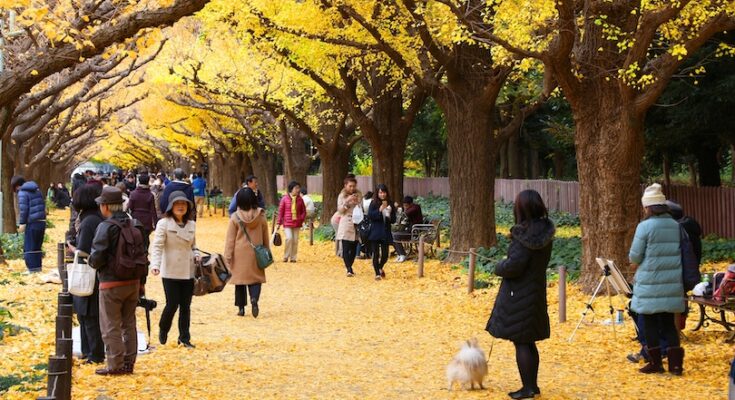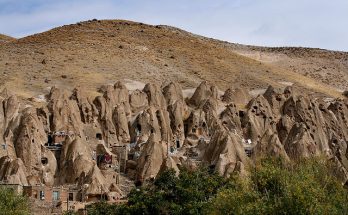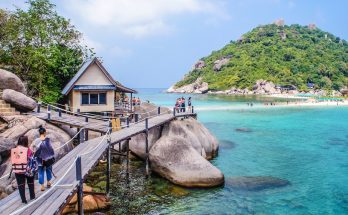The largest city in the world, Tokyo is a fun, fascinating, futuristic place to visit. Whether it’s ancient temples and neon-lit cityscapes you’re after or eclectic fashion, cutting-edge electronics and anime, Japan’s cool capital has you covered.
Each year, millions visit the massive metropolis, to try its fresh sushi and ramen and experience the frenetic, fast-paced feel. The most popular seasons are spring and autumn as the blooming cherry blossoms and beautiful foliage look spectacular.
To help you organize your trip, let’s take a look month-by-month at what life is like in Tokyo. This will give you an idea of what to expect in terms of its climate, crowds and main cultural events.
What’s the Weather Like in Tokyo?
Located in the humid subtropical climate zone, Tokyo, like most of the rest of Japan, actually has five distinct seasons. While summers are very hot and humid with averages of about 29 to 31°C (84 to 88°F), winters are cool, but dry, with some occasional cold spells.
From March to October, it rains quite a lot between 16 and 20 days on average. Umbrellas are sold at innumerable convenience stores, so you can easily grab one if you’re out and it starts tipping down. The rainy season or tsuyu normally lasts for roughly a month around late May and June. Its skies are overcast with constant drizzle and sudden downpours.
Otherwise, both spring and autumn are very comfortable temperature wise though typhoons sometimes hit later in the year. Picturesque azaleas and blooming cherry and plum trees dot the parks with the fiery colours of its foliage also attracting huge crowds of onlookers.
Best months to visit Tokyo

As there is always something new and interesting going on, Tokyo is a fantastic year-round destination. Most of the main attractions and museums can be enjoyed at any time, as can the unique culture, cuisine and exciting city life.
Having said that, there are, of course, better times to visit weatherwise. Both March to May and September through November are usually considered the perfect periods to go. Besides seeing the stunning sakura and glittering golden leaves of the trees, the milder temperatures are more pleasant for exploring the capital.
Despite the oppressive heat and humidity making wandering about a sticky, sweaty ordeal, many still visit in July and August. Making up for the higher prices and huge crowds are the Sumida River Fireworks Festival and Asakusa Samba Carnival taking place then.
The only quieter and cheaper months are January and February. Although the days are drier, the colder temperatures put most people off, meaning you can find some great deals.
Tokyo in January

Once the Christmas holidays and New Year’s celebrations are over, January is the least popular month of the year to head to Tokyo. While temperatures hover around 10°C (50°F), the air is crisp and clean and the skies are sunny and blue. Due to the great visibility, this is one of the best times to see Mount Fuji covered in snow. Bathing in Hakone’s hot springs is also particularly pleasant as the weather outside is so cold.
Hotel prices and airfares are also cheaper once Hatsumode – the first shrine visit of the year – and the holidays are over. Many shops, museums and tourist sights may close for the first few days of January. Apart from that, you’ll find no queues at any of the attractions though the city is, of course, always busy with people rushing about.
Tokyo in February

February is very similar weatherwise to January and it sometimes snows for a day or two if you’re lucky. While the days are dry and sunny and there are about 11 hours of daylight, this is a good time to warm up in an onsen or with a hot bowl of ramen. Sensoji and Zojoji temples hold traditional Setsubun festivities to mark the end of winter.
As it is also the low-season, prices are affordable with fewer tourists found at its teamLabs’ immersive art installations. As you’ll want to spend more time indoors, it’s well worth hitting up some of the museums. On National Foundation Day, processions and music performances are held to celebrate the country’s founding.
Tokyo in March

As the cherry and plum trees start to bloom, March sees a huge increase in visitor numbers to the city. From the middle of the month onwards, Ueno, Chiyoda and Sumida Park all hold sakura festivals, continuing into early April. The parks all look pretty with averages of 13°C (55°F) being better for walking about in. Make sure to take an umbrella or jacket around with you though, as it rains quite a bit.
Before the blossoms arrive, prices are again lower as there are fewer people around. This all changes once the sakura season starts. Popular events to attend in March include the Tokyo Marathon and AnimeJapan where you can shop for manga, figurines and snap pics with your favorite characters. Art Fair Tokyo also has lots of amazing artworks to admire and buy.
Tokyo in April

With the weather warming up and the wonderful cherry blossom festivals taking place, April is one of the busiest months in Tokyo. Vast crowds sit and stroll about its parks, watching all the delicate pink petals blowing in the wind. Averages of 19°C (66°F), and the longer days, are great for being outdoors or taking scenic trips to see Hakone and Mount Fuji.
Prices are, however, at their highest with its hotels, restaurants and attractions all rammed – you’ll need to book many places in advance. Once the sakura season is over, there is a brief lull before Golden Week begins at the end of April. Tokyo also has the Great Wisteria Festival to attend at Ashikaga and fun parties and parades to take part in for Tokyo Rainbow Pride.
Tokyo in May

At the beginning of May, Tokyo’s airports and rail stations are completely overrun as millions of Japanese travel around the country for Golden Week. Prices are way more expensive with most of its main attractions and museums teeming with people.
While the days are sunnier, warmer and longer, a lot of rain comes down, particularly at the end of the month. Spring is in the air though, with all its azaleas and hydrangeas making for some fabulous photos.
Early May also has tons of traditional events to enjoy with enormous crowds coming to take part in them. Classical theater, dance and music performances are held for the Meiji Shrine Spring Grand Festival while Kurayami Festival has parades of floats and horseback archery.
The Kanda Matsuri – one of Tokyo’s most famous festivals – also sees massive processions at some of its main temples and neighborhoods.
Tokyo in June

As it rains an incredible amount – 20 days on average – June is a bit quieter than May. While temperatures rise to 25°C (77°F) and there are 15 hours of daylight each day, the endless drizzle and downpours make walking about outside less pleasant. If you don’t mind grey skies and take an umbrella, there are pretty iris and hydrangea festivals going on.
After Golden Week and the cherry blossom season, hotel prices and airfares are finally a bit more affordable. There will still be fewer crowds at shrines, museums and temples due to the bad weather.
Another of the city’s most important festivals – the Sanno Matsuri – also kicks off in June for 11 days. This sees colourful floats and costume-clad people parade about the capital’s streets.
Tokyo in July

With the onset of summer, Tokyo becomes very hot and sticky in July. Coupled with the high humidity, averages of 29°C (84°F) make sightseeing quite tiring. With it also raining for about 19 days, you’ll want to spend time in its air-conditioned museums and malls. On the plus side, Mount Fuji’s trails open again after the winter if you want to summit the iconic volcano.
Although it is not quite as busy as August, airfares have already shot up due to the summer holidays. There are also more crowds despite the uncomfortable weather conditions. As the climate is cooler, it’s a lovely time to hike around Nikko’s mountains, forests and waterfalls. Otherwise, there are spectacular shows to enjoy at the Sumida River Fireworks Festival.
Tokyo in August

August is even worse weatherwise as averages of 31°C (88°F) and the high humidity are almost unbearable at times. That doesn’t stop it from being one of the most popular months to visit Tokyo as many people have holidays. Millions of Japanese also travel about the capital and country for Obon – a Buddhist festival commemorating deceased ancestors.
While it still rains quite a lot, there are about 6 hours of sunshine a day to wander about in. Torrential rains and fierce winds sometimes hit but only rarely. Most tourist attractions and theme parks will be very full though with hotels and airfares also at their most expensive.
In addition, both the exotic Asakusa Samba Carnival and the water-splashing Fukagawa Hachiman Festival attract large crowds.
Tokyo in September

Despite September being almost as rainy as June, the heat, humidity, crowds and prices are nowhere near as bad as summer. This makes it a great time to go with the beginning of the month also being the last opportunity to hike Mount Fuji before the trails close again.
While the start of September sees averages remain around 27°C (80°F), the city cools down later on. Typhoons can sometimes disrupt travel plans but seldom impact life in Tokyo.
Due to the weather, the visibility and views from atop the Skytree and Tokyo Tower are normally not quite so good. You can, however, explore its temples, gardens and museums with fewer people around – just take an umbrella with you!
Tokyo in October

With autumn arriving in October, more people visit the capital again. While it still rains a lot, the cooler temperatures are ideal for ambling about its parks, admiring their glittering golden leaves. As the fiery foliage looks so stunning, it’s worth taking trips to either Nikko or Kamakura.
As the days are usually sunny and warm with the evenings being a bit chilly, it’s a good idea to layer up. Many temples and gardens hold lovely chrysanthemum festivals with its ten-day International Film Festival also going on. Costumed revelers often celebrate Halloween at Shibuya Crossing with Hello Kitty Land and Disneyland also putting on lots of fun festivities.
Tokyo in November

As it is slightly quieter, cheaper and less crowded, November is a great month to visit Tokyo. While temperatures drop to 17°C (62°F), the days are much drier with skies being bright and blue. Many locals and tourists head to Mt. Takao which has traditional drum, dance and music performances to enjoy at its Autumn Leaves Festival.
Aside from National Cultural Day, which sees parades and art exhibitions take place around the city, hordes of people visit temples and shrines for Tori-no-Ichi. Asakusa has numerous festivities going on as worshipers wish for good fortune on these auspicious days. Strolling about Tokyo’s gardens is particularly pleasant due to the wonderful colors and weather.
Tokyo in December

While Christmas has only been celebrated in Japan for the last few decades, Tokyo goes all out with spectacular lights and decorations strung up wherever you look. Other than perusing its shops and Christmas markets, its theme parks put on special shows and firework displays. A fun, festive month, December is dry but cold with temperatures averaging 12°C (53°F).
Around New Year’s, prices shoot up with many attractions and museums closing for a couple of days. Countless events and countdown celebrations are held with prayers and bell-ringing rituals taking place at its temples. If you wrap up warm, December is a magical time to visit as you get to experience all the unique ways that the Japanese celebrate Christmas.



